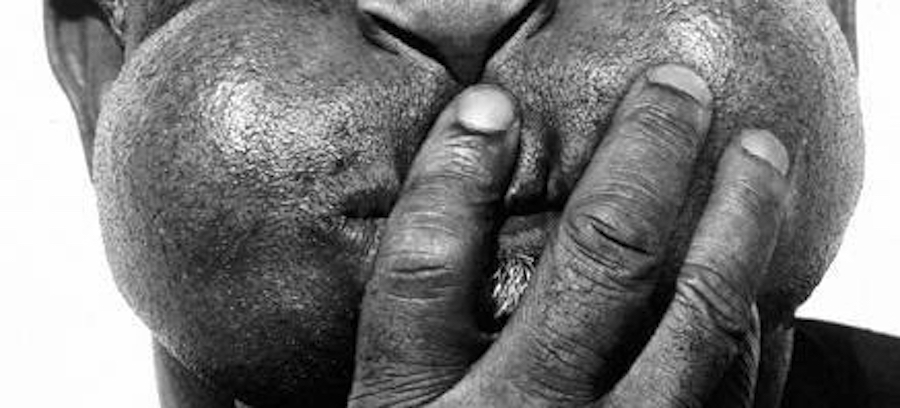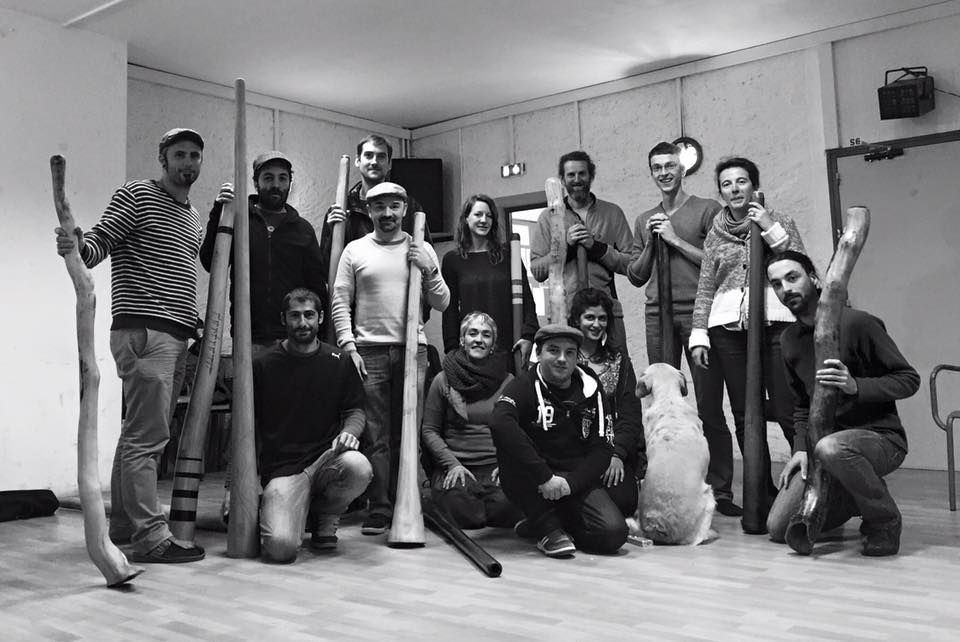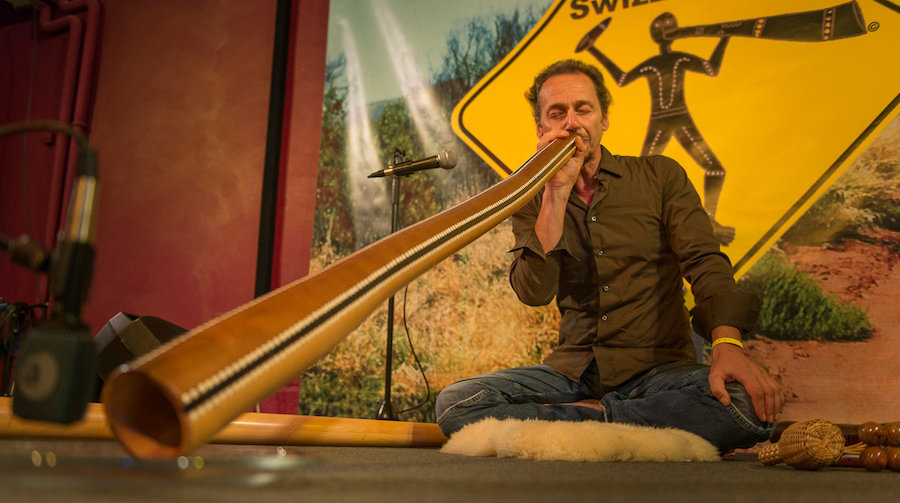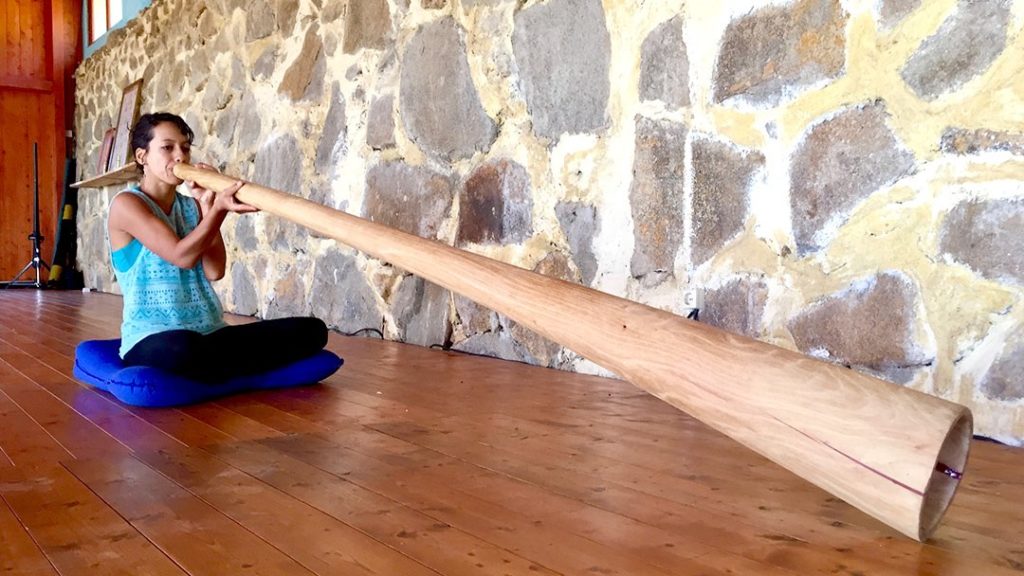You want to learn to play the didgeridoo? A friend quickly showed you how to make some sounds on a didgeridoo? And then what? I bet you did not really know where to go from there! Here are 10 tips to help anyone who is starting to play and is feeling a little lonely on the way.
Hello, my didg blowing friend!
Tip # 1: Pay attention to your didgeridoo mouthpiece
Having a good mouthpiece is essential. Initially, we tend to neglect the mouthpiece thinking it is not of primary importance, however it really has a great influence on playing. Indeed, if it is too open or, on the contrary, too closed, you will experience greater difficulty in producing a stable sound and it will also be more difficult to vary your sounds.
The ideal size of a mouthpiece is about 30-32 millimeters and it should have a round and consistent shape. An entry-level – or sometimes a traditional – didgeridoo will have a mouthpiece made of beeswax. This kind of mouthpiece, which offers the advantages of being both affordable and natural, can really be found most anywhere.
However, this type of mouthpiece may become soft after a few hours of play. It is therefore not uncommon to see mouthpieces that have been completely warped over time and these deformities can cause air leakage between your lips and your didgeridoo.
Another mistake is to constantly change the shape of the mouthpiece. We might play the didgeridoo and then, thinking that we will play better, we change the size and diameter of the mouthpiece a bit … and this rarely causes us to actually play better. After a few days the mouthpiece is completely deranged!
<strongKeep this advice in mind: a good mouthpiece is round and consistent with a diameter between 30 to 32 mm – and one that you leave as it is! :-).
Your mouthpiece is no longer cutting it? Read the article: 4 steps to making your own beeswax mouthpiece for your didgeridoo.)
Tip # 2: The Importance of Your Posture During Your Didgeridoo Sessions
Posture is very important. Be mindful of sitting in a good position as this will help you play better. Keep your back very straight and make sure to place the bell of your didgeridoo at least at the level of your seat. This will save you from constantly having your neck bent forward. Also be sure to bring the didgeridoo to your mouth and not the other way around. Often beginners (and even some advanced players!) lengthen their necks to reach their mouthpieces when it is more convenient to bring the mouthpiece closer to your mouth – you will see it works well! If you want to dive deeper into the subject, here is an article in which I give you Five tips for a good posture to play your didgeridoo.
Tip # 3: Find the right pressure in your didgeridoo
An essential element to progressing quickly in playing the didgeridoo is to find the proper pressure for your instrument. To understand the importance of pressure, you should know that each didgeridoo is designed to be played at a very specific level of pressure. One common mistake is to play your didgeridoo well below the appropriate pressure level. This small detail will have major repercussions: your sound will be dull, devoid of harmonics (your didgeridoo’s high notes), with a stuffy bass and imprecise attacks. On the contrary, if you apply too much pressure your sound will be nasal, with a low bass and a muffled vibration.
Respect the limits of your body and you will see that little by little it will adjust, slowly but surely, to the practice of the didgeridoo.
So to play with the appropriate amount of pressure, pinch your lips or think of smiling – this will have the effect of stretching your lips and will therefore produce pressure.
You can also watch this video which will help you improve your didgeridoo sound with pressure (English subtitles)
What is the pressure in the didgeridoo ?!
Pressure is the result of two factors: the air you blow as you empty your lungs and the air you hold by pinching your lips.
The balloon example
To better understand pressure, imagine an inflated balloon that you are holding in your hands, taking care to pinch the tip or opening of the balloon. If you release the balloon opening too quickly, it will deflate all at once. If, on the other hand, you let only a trickle of air pass, you will begin to create pressure. Finally, if you press your hand against the balloon while maintaining the air stream, you will increase the pressure.
The opening of the balloon represents your lips, the balloon itself represents your lungs and your hand represents your abdominal muscles. Initially, your cheek and abdominal muscles will not be accustomed to being contracted in this way.
Tip # 4: Pay attention to your cheeks!
When we first start playing the didgeridoo, we have the tendency to allow our cheeks to puff up rather automatically. This makes a good deal of sense, as it is the most natural position for us as it requires almost no muscle contraction. Although this is not really a mistake, it is better to try to avoid puffing your cheeks up for two main reasons:
- First of all, the cheeks act as a filter on your sound. In other words, the cheeks will camouflage the movements of your tongue and therefore your variations will sound less distinct.
- Furthermore, when the cheeks remain puffed up, they will prevent you from pinching your lips to achieve the appropriate level of pressure (see tip # 3).
 That said, it is not necessarily “bad” to puff up your cheeks! You will need to do so, for example, when playing with learn circular breathing. You just have to be able to move from one position to another.
That said, it is not necessarily “bad” to puff up your cheeks! You will need to do so, for example, when playing with learn circular breathing. You just have to be able to move from one position to another.
To summarize, you should understand that deflated cheeks will help you to play more precise sounds and puffed up cheeks will allow you to work the continuous breath.
If you do not want your cheeks to puff up, here is a tip: smile or pinch your lips together as you did in the pressure exercise but this time play in front of a mirror to see what happens. If done correctly, you should be able to hear less bass and you will begin to hear higher notes.
Tip # 5: Playing facing forward, or frontwards, is much better!
It is definitely tempting to start playing from the side! It is true that at first this makes it easier to produce sound and control your lips. That said, this fact fades quickly as you continue progressing and you really must believe me (really!) that players who start playing from the side end up playing facing forward. I also played from the side for two years and of course I ended up playing from the front. It is just better :-). If you still have doubts, read this article or watch the video I made about playing your didgeridoo facing forward. If I did my job well, it should end up convincing you!
• • •
“Great works are performed not by strength but by perseverance.”
Samuel johnson
• • •
Tip # 6: Practice your didgeridoo regularly
To progress in music, it is better to play regularly for 10 minutes each day than it is to play 3 hours every 15 days. The didgeridoo is of course about dexterity, but above all there are a lot of muscles that you must work. Your lips, your tongue, and your entire respiratory system need to strengthen.
Playing regularly allows you to take the time needed to get used to the new ‘gymnastics’ and the new sensations. It is normal for you to have moments of discouragement. You will see that there are days when everything goes well and other days where nothing seems to work: your sound is off, your lips suddenly stop working, and basically nothing goes as you would like it to go!
Do not push it; simply begin anew the next day. Over time these ups and downs will subside and will eventually almost disappear. And you will see, the more you play the more enjoyable it will become!
Tip # 7: Above all, have fun with your didgeridoo!
“I have to practice my instrument.” Ahhh, what a great mistake it is to say this! Promise me that as soon as you think of this phrase you will replace it with “I want to have some fun with my didgeridoo!” It’s so important to enjoy playing your didgeridoo and to play it for fun. Do not force yourself to play and remember “why” you play.
I will take advantage of this little piece of advice to share a personal experience with you. Initially, I played my didgeridoo for the pleasure of discovery. I simply found playing to be wonderful, so I was very motivated and I played many hours a day. And then over time, I started to make myself known and I ended up playing for the purpose of becoming the best … What a mistake! As a result, I had to stop playing for two years in order to re-encounter true pleasure! I talk about it in this article: How to guarantee you lose your passion for the didgeridoo (or for music in general) .
Play for your own pleasure; slow down and appreciate your own playing. Learn to play with joy and enthusiasm in all their simplicity.
Tip # 8: Meet Didgeridoo Players or Take Didgeridoo Classes
Meeting with others is a big factor in progressing. Whether it is just a quick meeting, going to a concert, playing in a local association or even exchanging music with other players, all of these experiences will allow you to progress much more quickly. They will give you the chance to listen, to discuss this or that technique, and to play with other players if your heart tells you to do so.
The didgeridoo masterclass are also a good way to progress, they help you to avoid bad habits and prevent you from getting discouraged.

Didgeridoo course given in Pau to the Pyrat vibes association
Tip # 9: Listen to didgeridoo
Have you heard of Dr. Alfred Tomatis? He did some research in the 1960s-90s that showed that we only reproduce the sounds which our ears can hear. So in France if someone has an English accent when he/she speaks, which can be charming but cuts like a knife, it is simply because the English use higher sounds than the French use. Being unaccustomed to these high frequencies makes us reproduce them with great difficulty … hence the legendary accent!
By listening to the didgeridoo you will familiarize your ear with a number of different sounds while at the same time being more able to reproduce them. I myself had no musical ear (I was the antithesis of a musician!) and yet I can now say without too much risk, that I developed a very good ear for the didgeridoo (…and only for didgeridoo! Yes; I listened a lot!!). I can now accurately analyze the tongue movements of the player to whom I am listening.
And the best part of the story is that all this can be done on your own. All you have to do is listen to didgeridoo! You can discover 10 Australian didgeridoo players or listen to the main European players. Of course, I’m counting on you to already have my two albums in your collection. ?

Denra Dürr at the Swiss didgeridoo festival: the Swizzeridoo
Tip # 10: Demystify circular breathing!
You’ve probably noticed that when you say you play the didgeridoo, people reply, “Oh yes? And do you do that technique where you do not stop blowing? The continuous breath I mean? It’s really a super hard thing to do. It’s impossible!!”.A tip: do not listen to these people. In fact, if you question them, you will realize that either:
- they have actually never tried to play circular breathing…
- they tried for 10 minutes on a sofa (yes, the sofa detail is important!)
- they have not been taught to do the the right exercises (send them over to me, I will set them straight!)
In any case, we can quickly understand why it did not work out for them.
Oh yes, one thing I should also mention: forget about the straw with the glass of water exercise. This exercise is very common on the internet and it is relatively useless. Indeed, the air needed to produce the bubbles in the glass of water is considerably less than the air used to vibrate your didgeridoo. I can assure you that these (free) exercises on circular breathing work much better!
• • •
“Act like it’s impossible to fail.”
Winston Churchill
• • •
Make a clean slate of your prejudices. Leave aside the legend that made circular breath a technique reserved for a handful of insiders. Trust your body and just let yourself be taken away. Of course, we are not all equal in the face of continuous breath – some will get it in a few minutes while others will take months to get it down. But the more you practice, the easier it will become.
Those who manage to learn it in a few minutes all have one thing in common: they simply try.
Before starting the circular breathing exercises, stabilize your sound, find your pressure and be able to go through a game with puffy and deflated cheeks .
Then, it will be time to learn how to play circular breathing and, believe me, if you respect these tips, you will master it quickly.

To conclude
I hope these tips will help you in learning to play the didgeridoo. I wish you happy playing and beautiful discoveries! And do not forget: play with your heart. It is so important.
If you have any questions, remarks, or advice to add, post a comment. And if you think this article can help another beginning player, share it. 🙂












